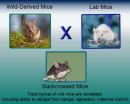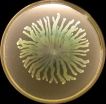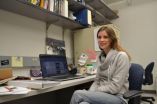(Press-News.org) Laboratory mice are one of the most common animal models used in biological and medical research. Thousands of laboratory mouse strains are produced by artificial selection – the process by which humans breed animals over dozens of generations for particular traits. This has led to the domestication of mice: strengthening specific qualities that make them well-adapted for research under laboratory conditions, such as rapid reproduction, while eliminating characteristics that are not conducive to research, for example, aggression, the desire and ability to escape from danger, and anxiety caused by environmental disturbances.
However, the artificial selection process also caused the mice to lose the very important trait of being able to survive in the wild. Besides these lost traits, the female lab mice developed the tendency to immediately mate with every male in their vicinity, including siblings and parents. That is, they lost the ability to selectivity choose a mate according to traits that "promise" the offspring better genes and a higher survival rate than those who share a common descent. At the same time, they evolved the willingness to take care of pups belonging to "strangers" (even if they are not themselves mothers). The strains of lab mice chosen to undergo further artificial selection are those who are not "fussy eaters," grow faster and reach sexual maturity more quickly relative to wild mice. That is how we ended up with larger, less aggressive mice that reproduce at a younger age and are less particular when it comes to choosing a mate. In other words, these strains are quite different from wild mice with regard to structural, physiological and behavioral features.
Dr. Tali Kimchi of the Weizmann Institute's Neurobiology Department understood that these laboratory mouse strains are not suitable for answering some types of questions posed by her research, which focuses on the neural and genetic roots of social behavior, including reproduction and maternal instinct (for example, a mother's aggression toward another's offspring, and the role of odors – pheromones – in mate selection and caring for offspring). Therefore, Kimchi had to develop a unique mouse strain, restoring those properties removed from the laboratory mouse strains, while retaining the ability to employ genetic engineering tools to create mutant strains (a genetic change that disables the function of a particular gene).
To do this, Kimchi and her research group backcrossed strains of laboratory mutant mice that had a specific mutation in the gene responsible for detecting pheromone signals, with wild-derived (undomesticated) mice for ten generations. As a result, in these new backcrossed strains of mice, the scientists managed to reinstate traits typical of wild mice, which were lost through the domestication process and are absent in laboratory strains, including those pertaining to behavior, body structure, hormones, various biological processes and genetic functions. More specifically, they restored, among other things, the ability to react to and escape from danger, spontaneous anxiety-related jumping and freezing behavior, and aggressive attacks toward other females. Another important feature that was restored in the new breed of mice was maternal instinct: Naïve (not yet mated and maternal) backcrossed wild-derived female mice were less likely to nurture another's pup they encountered. They were also aggressive toward those pups, as well as among themselves – just like wild mice.
The new mouse model created by Kimchi and her team has allowed them to explore, for the first time, the biological roots of aggressive behavior in females, both toward each other, and especially toward the pups of others. It also enabled them to locate a particular gene, which is responsible for the perception of pheromone signals, and to determine this to be the main cause for rejecting a stranger's pup, as well as the aggressive behavior displayed toward them. A pup's mother, it turns out, is the one and only, and stepmothers, naturally, are more aggressive toward others' offspring. Their findings, published in the journal Nature Communications, provide the basis for developing additional mouse strains that will enable a better understanding of the neural and genetic basis of behavior relating to reproduction in females, and the differences between males and females.
Kimchi hopes that further research will lead, in the future, to a renewed understanding of the biological mechanisms underlying social and reproductive processes that have not been possible to explore in standard models of lab mice until now. It may also lead to a better understanding of the social component of neuropsychiatric diseases, which is manifested in different ways in men and women. Such knowledge will contribute to improving the development of drugs targeted to the different sexes, and in particular, will enable an analysis of the effect of certain drugs on women.
INFORMATION:
Dr. Tali Kimchi's research is supported by the Nella and Leon Benoziyo Center for Neurological Diseases; the Murray H. & Meyer Grodetsky Center for Research of Higher Brain Functions; the Joan and Jonathan Birnbach Family Laboratory Fund; the Abisch Frenkel Foundation for the Promotion of Life Sciences; the Peter and Patricia Gruber Awards; Mike and Valeria Rosenbloom through the Mike Rosenbloom Foundation; the estate of Fannie Sherr; and the Irving B. Harris Fund for New Directions in Brain Research. Dr. Kimchi is the incumbent of the Jenna and Julia Birnbach Family Career Development Chair.
The Weizmann Institute of Science in Rehovot, Israel, is one of the world's top-ranking multidisciplinary research institutions. Noted for its wide-ranging exploration of the natural and exact sciences, the Institute is home to scientists, students, technicians and supporting staff. Institute research efforts include the search for new ways of fighting disease and hunger, examining leading questions in mathematics and computer science, probing the physics of matter and the universe, creating novel materials and developing new strategies for protecting the environment.
Weizmann Institute news releases are posted on the World Wide Web at http://wis-wander.weizmann.ac.il, and are also available at http://www.eurekalert.org.
Pheromones regulate aggression of non-mother female mice toward pups in wild-derived mice
2014-08-05
ELSE PRESS RELEASES FROM THIS DATE:
Eating more dietary pulses can increase fullness, may help manage weight
2014-08-05
TORONTO, Aug. 5, 2014 – Eating about one serving a day of beans, peas, chickpeas or lentils can increase fullness, which may lead to better weight management and weight loss, a new study has found.
A systematic review and meta-analysis of all available clinical trials found that people felt 31 per cent fuller after eating on average 160 grams of dietary pulses compared with a control diet, according to senior author Dr. John Sievenpiper of St. Michael's Hospital's Clinical Nutrition and Risk Factor Modification Centre.
His group's findings were published in the August ...
Social networking is key to helping bugs spread, study shows
2014-08-05
Fresh discoveries about how bacteria co-operate with each other when causing infection could help scientists identify animal diseases that might transmit to people.
Bugs that can co-operate best with each other are most likely to be able to jump to new species, including humans, a new study shows.
Bacteria interact by releasing molecules to help them adapt to their environment – for example, when killing competing infections in their victim. They co-ordinate these actions by releasing tiny amounts of chemicals as signals.
Bacteria that can co-operate to create an ...
LEDs made from 'wonder material' perovskite
2014-08-05
A hybrid form of perovskite - the same type of material which has recently been found to make highly efficient solar cells that could one day replace silicon - has been used to make low-cost, easily manufactured LEDs, potentially opening up a wide range of commercial applications in future, such as flexible colour displays.
This particular class of semiconducting perovskites have generated excitement in the solar cell field over the past several years, after Professor Henry Snaith's group at Oxford University found them to be remarkably efficient at converting light to ...
Smart bacteria help each other survive
2014-08-05
The body's assailants are cleverer than previously thought. New research from Lund University in Sweden shows for the first time how bacteria in the airways can help each other replenish vital iron. The bacteria thereby increase their chances of survival, which can happen at the expense of the person's health.
The bacteria Haemophilus influenzae is a type of bacteria in the respiratory tract that can cause ear infections and worsen the prognosis for COPD patients. In rare cases, it can also lead to meningitis and septicaemia.
"By accepting help from a specific protein, ...
Carnegie Mellon photo editing tool enables object images to be manipulated in 3-D
2014-08-05
PITTSBURGH—Editors of photos routinely resize objects, or move them up, down or sideways, but Carnegie Mellon University researchers are adding an extra dimension to photo editing by enabling editors to turn or flip objects any way they want, even exposing surfaces not visible in the original photograph.
A chair in a photograph of a living room, for instance, can be turned around or even upside down in the photo, displaying sides of the chair that would have been hidden from the camera, yet appearing to be realistic.
This three-dimensional manipulation of objects in ...
Rituals can help older people remember to take their asthma meds
2014-08-05
Storing it in the bathroom and making it part of a daily routine may be helpful advice that doctors can give their older asthmatic patients who struggle to remember to take their daily prescribed medication. This advice comes from Alex Federman, Associate Professor of Medicine at the Icahn School of Medicine in New York City, senior author of a study which discusses how elderly asthmatics cope with taking their inhaled corticosteroid medication as prescribed. The findings appear in the Journal of General Internal Medicine, published by Springer.
The regular use of such ...
Clues to the ageing of tendons unlocked for the first time
2014-08-05
University of Liverpool scientists have examined the mechanisms that cause ageing in the tendons of horses, opening up the possibility of better treatment for humans.
It has been understood for many years that tendons are highly prone to injury and that this likelihood increases as they age. Why this happens, is currently poorly understood
Now, using samples taken from young and old horses, which have similar tendon properties to those of humans, the team of researchers, which also included scientists from Queen Mary University of London, performed a range of tests ...
Scientists call for increased conservation efforts to save black bears
2014-08-05
COLUMBIA, Mo. – Between 1880 and 1920, the Central Interior Highlands (CIH), consisting of Missouri, Oklahoma and Arkansas, saw the height of deforestation that also decreased the habitat for black bears and other forest species. To combat the decline of black bears and repopulate the mountainous region, more than 250 bears from Minnesota and Manitoba were relocated to Arkansas in the 1950s and 1960s. Now, researchers at the University of Missouri have analyzed genetic diversity in black bears in the CIH and have determined that coordinated conservation management is still ...
Obesity paradox in survival from sepsis
2014-08-05
ANN ARBOR, Mich. – University of Michigan Health System researchers revealed an obesity paradox among older Americans suffering from sepsis.
In a study of 1,404 Medicare beneficiaries, heavier patients were more likely to survive sepsis, a life-threatening infection that can lead to a stay in a hospital's intensive care unit.
The findings, published in the August issue of Critical Care Medicine, raise interesting questions about how obesity impacts the body's response to infection. Obesity is most often connected with worse, not better, health outcomes.
"Physicians ...
Researchers determine why tendons break down with age
2014-08-05
Scientists at Queen Mary University of London (QMUL) have identified differences in the proteins present in young and old tendons, in new research that could guide the development of treatments to stop tissue breakdown from occurring.
Tendon structure in horses is similar to humans, and both face common injuries. The researchers used a horse model to undertake a thorough analysis of all the proteins and protein fragments present in healthy and injured tendons.
Working with scientists at the University of Liverpool, the team collected data, which shows that healthy, ...






